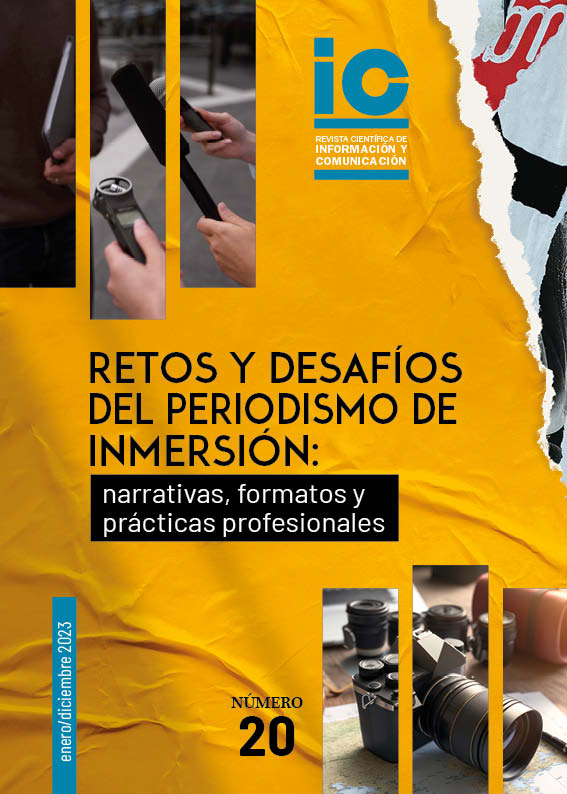Emergency communication through Twitter: level of activity, communication functions and interactions of the institutions and spokespersons involved in the wildfires in Sierra Bermeja, Málaga
DOI:
https://doi.org/10.12795/IC.2023.I20.16Keywords:
Crisis, digital spokespersons, emergency communication, risk, Twitter, wildfiresAbstract
This article analyzes the communication management carried out by institutions and spokespersons on Twitter about the intentionally set fires in Sierra Bermeja, Málaga, in September 2021. The goals are to analyze the number of messages, their communicative purpose, and the level of interaction achieved. To this end, a content analysis of 582 tweets has been carried out. The main conclusion is that the institutions took advantage of their messages for self-propaganda purposes.
References
Calleja-Reina, María Antonia, Paniagua Rojano, Francisco Javier, & Victoria Mas, Juan Salvador (2018). Herramientas digitales y Comunicación de Crisis: El papel de las redes sociales según la voz de los expertos (2015). Estudios sobre el mensaje periodístico, 24(2), 1147. https://doi.org/10.5209/ESMP.62206
Carrasco-Polaino, Rafael, Martín-Cárdaba, Miguel Ángel, & Villar-Cirujano, Ernesto (2021). Participación ciudadana en Twitter: Polémicas anti-vacunas en tiempos de COVID-19. Comunicar: Revista científica iberoamericana de comunicación y educación, 69, pp. 21-31. https://doi.org/10.3916/C69-2021-02
Europa Press (1 de enero de 2022). Los incendios queman más de 85.000 hectáreas en 2021, con 18 grandes incendios como los de Navalacruz o Sierra Bermeja. EuropaPress Medio Ambiente. https://shorturl.at/axSWZ
García-Santamaría, José-Vicente, Pérez-Serrano, María-José, & Rodríguez-Pallares, Miriam. (2020). «Portavoces oficiales y estrategia audiovisual en la crisis de la Covid-19 en España». Profesional de la información, v. 29, n. 5, e290513. https://doi.org/10.3145/epi.2020.sep.13
Glik, Deborah C. (2007). Risk communication for public health emergencies. Annual review of public health, 28, pp. 33-54. https://doi.org/10.1146/annurev.publhealth.28.021406.144123
Hansson, Sten, Orru, Kati, Siibak, Andra, Bäck, Astra, Krüger, Marco, Gabel, Friedrich, & Morsut, Claudia (2020). Communication-related vulnerability to disasters: A heuristic framework. International journal of disaster risk reduction, 51, 101931. https://doi.org/10.1016/j.ijdrr.2020.101931
Interactive Advertising Bureau Spain. (2022). Estudio de redes sociales 2021. IAB Spain https://shorturl.at/bgPT5
Lowrey, Wilson, Evans, William, Gower, Karla K., Robinson, Jennifer A., Ginter, Peter M., McCormick, Lisa C., & Abdolrasulnia, Maziar (2007). Effective media communication of disasters: pressing problems and recommendations. BMC Public Health, 7(1), pp. 1-8. https://doi.org/10.1186/1471-2458-7-97
Manoj, Balakrishnan, & Baker, Alexandra Hubenko (2007). Communication challenges in emergency response. Communications of the ACM, 50(3), 51-53. https://doi.org/10.1145/1226736.1226765
Marcos-García, Silvia, Alonso-Muñoz, Laura, & López-Meri, Amparo (2021). Campañas electorales y Twitter. La difusión de contenidos mediáticos en el entorno digital. Cuadernos. info, (48), 27-47. https://doi.org/10.7764/cdi.48.27679
Pont-Sorribes, Carles, Suau-Gomila, Guillem, & Percastre-Mendizábal, Salvador (2020). Twitter as a communication tool in the Germanwings and Ebola crises in Europe. Analysis and protocol for effective communication management. International journal of emergency management, 16(1), 22-40. https://doi.org/10.1504/IJEM.2020.110106
Raj, Adharsh, & Goswami, Manash Pratim (2020). Is fake news spreading more rapidly than COVID-19 in India. Journal of Content, Community and Communication, 11(10), 208-220. https://doi.org/10.31620/JCCC.06.20/15
Segado-Boj, Francisco, Díaz-Campo, Jesús, & Quevedo-Redondo, Raquel (2019). Influence of the ‘News Finds Me’ Perception on News Sharing and News Consumption on Social Media. Communication Today, 10(2), 90– 105. https://shorturl.at/dGNZ9
Stephens, Keri K., Barrett, Ashley K., & Mahometa, Michael J. (2013). Organizational communication in emergencies: Using multiple channels and sources to combat noise and capture attention. Human Communication Research, 39(2), pp. 230-251. https://doi.org/10.1111/hcre.12002
Suau-Gomila, Guillem, Mora-Rodríguez, Michael, & Pont-Sorribes, Carles (2022). Twitter como herramienta de comunicación de emergencias: análisis de los perfiles institucionales y propuestas de mejora a partir de los atentados de Barcelona y Cambrils de 2017. Estudios sobre el Mensaje Periodístico 28 (2), 433-446. https://dx.doi.org/10.5209/esmp.77692
Suau-Gomila, Guillem, Sánchez-Calero, María Luisa, & Pont-Sorribes, Carles (2021). Evolución del uso de Twitter como herramienta comunicativa en emergencias sanitarias: el caso de la Listeriosis y el Ébola en España. Revista Científica de Información y Comunicación, 18(1), 279-304. https://dx.doi.org/10.12795/IC.2021.I18.14
Torpan, Sten, Hansson, Sten, Rhinard, Mark, Kazemekaityte, Austeja, Jukarainen, Pirjo, Meyer, Sunniva Frislid, Abriel Schieffelers, Abriel, Lovasz, Gabriella, & Orru, Kati (2021). Handling false information in emergency management: A cross-national comparative study of European practices. International journal of disaster risk reduction, 57, 102151. https://doi.org/10.1016/j.ijdrr.2021.102151
UNDRR (2022). Informe de Evaluación Global sobre la Reducción del Riesgo de Desastres. Naciones Unidas. https://shorturl.at/ksv19
Watson, Hayley, Finn, Rachel L., & Wadhwa, Kush (2017). Organizational and societal impacts of big data in crisis managment. Journal of Contingencies and Crisis Management, 25(1), pp. 15–22. https://doi.org/10.1111/146


